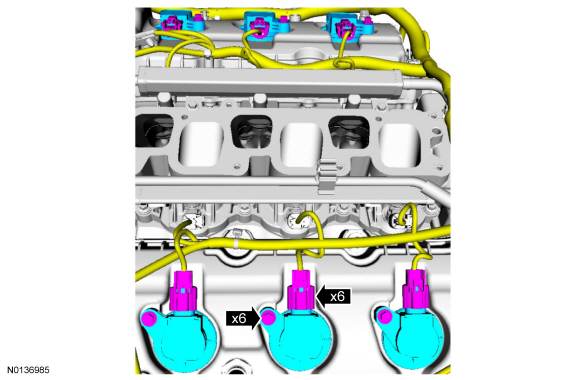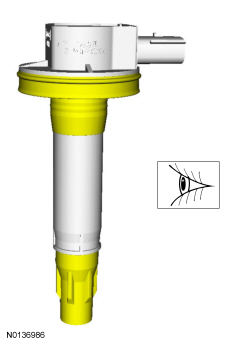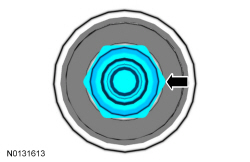SPECIFICATIONS
Material

General Specifications

Torque Specifications

DESCRIPTION AND OPERATION
Engine Ignition
Component Location
3.7L Ti-VCT


System Operation
REFER to the PC/ED manual section 1 Description and Operation.
Component Description
REFER to the PC/ED manual section 1 Description and Operation.
DIAGNOSIS AND TESTING
Engine Ignition
For PCM DTCs, REFER to Section 303-14 PCM DTC Chart. For driveability symptoms without DTCs, refer to the PC/ED manual, section 3 Symptom Charts.
REMOVAL AND INSTALLATION
Ignition Coil-On-Plug
Material

Removal and Installation
RH side
NOTE: Removal steps in this procedure may contain installation details.
- NOTE: The upper intake manifold must be removed to access the RH
ignition coil-on-plugs.
Remove the upper intake manifold. For additional information, refer to Section 303-01D.
Both sides
- NOTE: When removing the ignition coil-on-plugs, a slight twisting
motion will break the seal and ease removal.
NOTE: Before installing the ignition coil-on-plug apply a small amount of dielectric grease to the inside of the ignition coil-on-plug boots.
- Tighten to 7 Nm (62 lb-in).

- Inspect the ignition coil-on-plug rubber seals and boots for cracks, rips, or tears. Replace any damaged coil-on-plug rubber seals or boots.

- To install, reverse the removal procedure.
Spark Plugs
Removal and Installation
NOTE: Removal steps in this procedure may contain installation details.
- Remove the 6 ignition coil-on-plugs. For additional information, refer to Ignition Coil-On-Plug.
- NOTICE: Only use hand tools when removing or installing the
spark plugs or damage can occur to the cylinder head or spark plug.
NOTICE: The spark plug procedure must be followed exactly or damage to the cylinder head and spark plug will result.
NOTICE: Do not remove the spark plugs when the engine is hot or cold soaked. Spark plug thread or cylinder head damage can occur. Make sure the engine is warm (hand touch after cooling down) prior to spark plug removal.
NOTE: Use compressed air to remove any foreign material in the spark plug well before removing the spark plugs.
- Tighten to 15 Nm (133 lb-in).

- Inspect the spark plugs. For additional information, refer to Section 303-00.
- To install, reverse the removal procedure.
 Engine Ignition - 2.0L GTDI
Engine Ignition - 2.0L GTDI
SPECIFICATIONS
Material
General Specifications
Torque Specifications
DESCRIPTION AND OPERATION
Engine Ignition
Component Location
System Operation
REFER to the PC/ED manual
sect ...
 Engine Emission Control
Engine Emission Control
SPECIFICATIONS
Material
Torque Specifications
DESCRIPTION AND OPERATION
Engine Emission Control
Component Locations
2.0L GTDI
3.5L Ti-VCT and
3.7L Ti-VCT
3.5L GTDI
S ...
Other materials:
Ignition switch
A. Off: The ignition is off.
Note: When you switch the ignition off and leave your vehicle, do not
leave your key in the ignition. This could cause your vehicle battery to
lose charge.
B. Accessory: Allows the electrical accessories, such as the radio, to
operate while the engine is not r ...
Pairing your phone for the first time
Note: SYNC can support downloading up to approximately 1000 entries
per Bluetooth-enabled cellular phone.
Note: Make sure the vehicle ignition and radio are turned on and the
transmission is in position P.
Note: To scroll through the menus, press the up and down arrows on
your audio system. ...
Disassembly
Engine
Special Tool(s)
Material
WARNING: Do not smoke, carry lighted tobacco or have an open flame of any
type when working on or near any fuel-related component. Highly flammable
mixtures are always present and may be ignited. Failure to follow these
instructions may result in serious person ...
